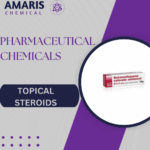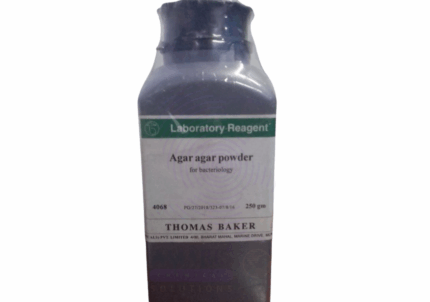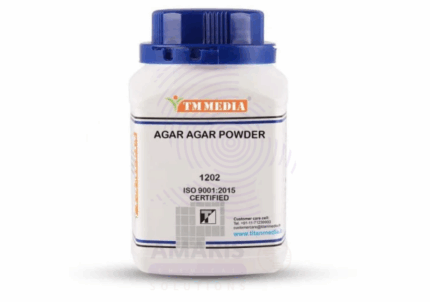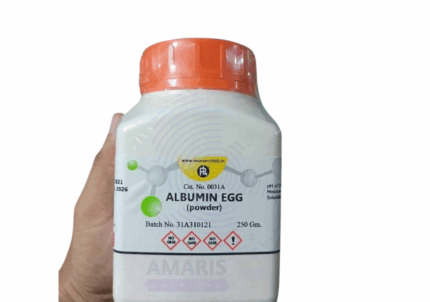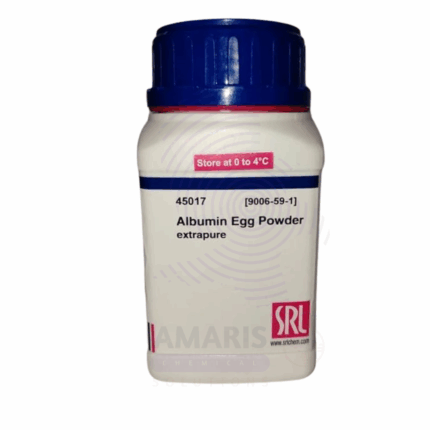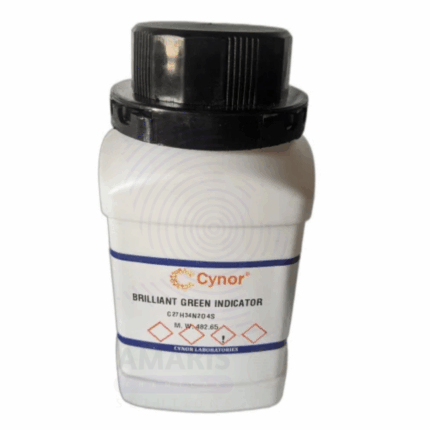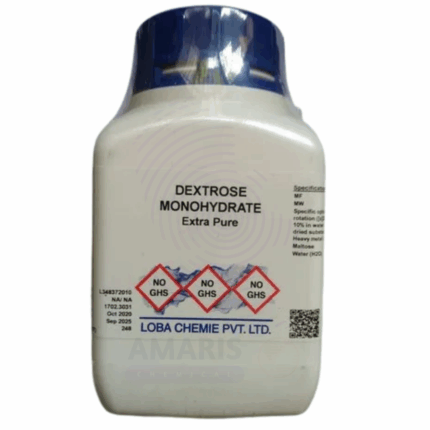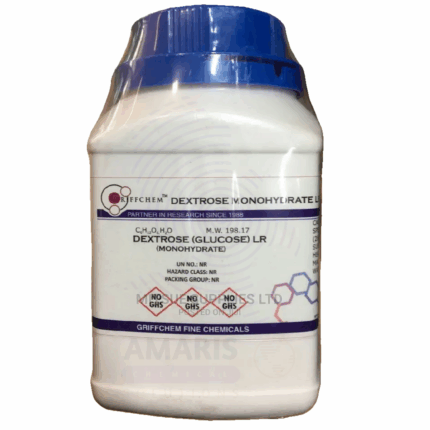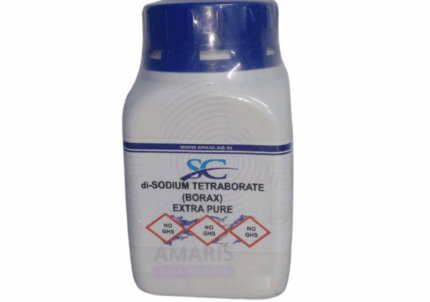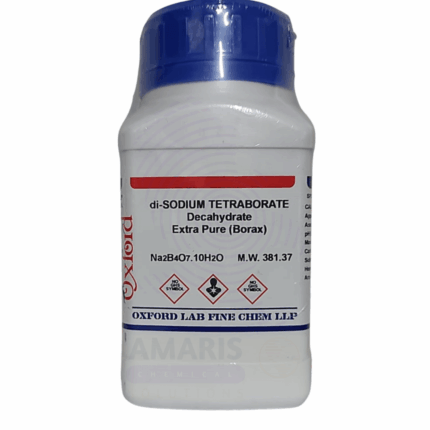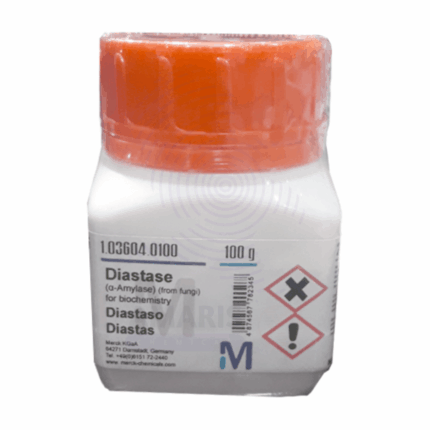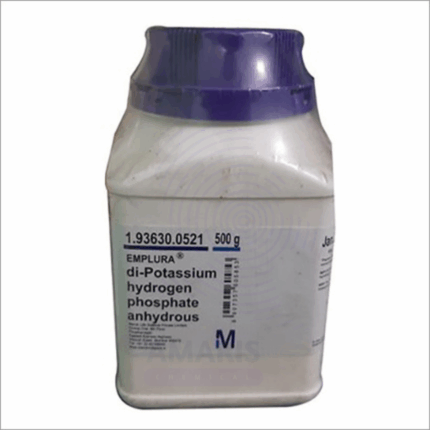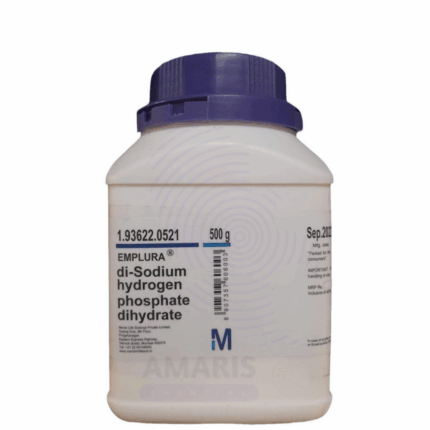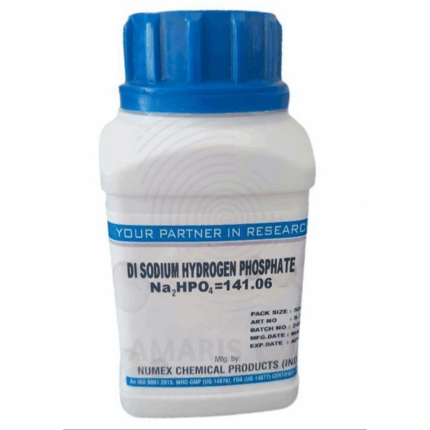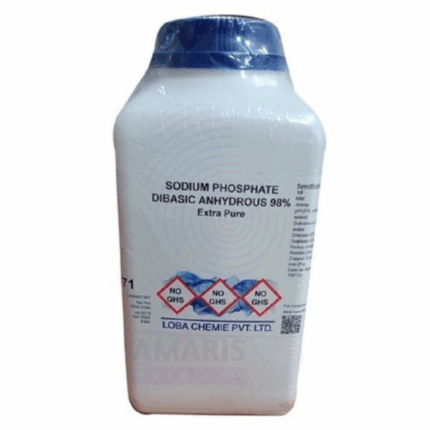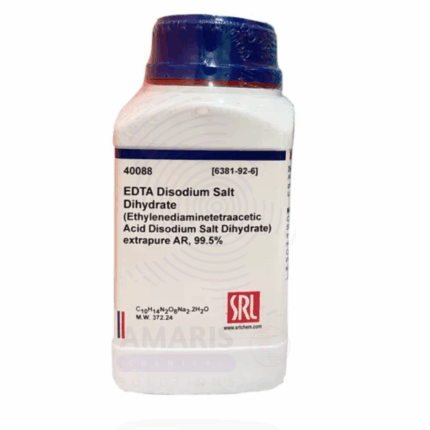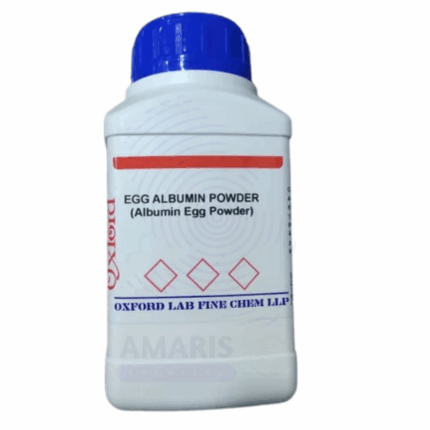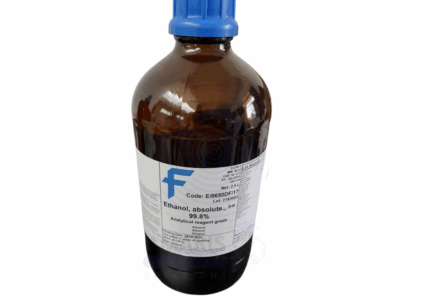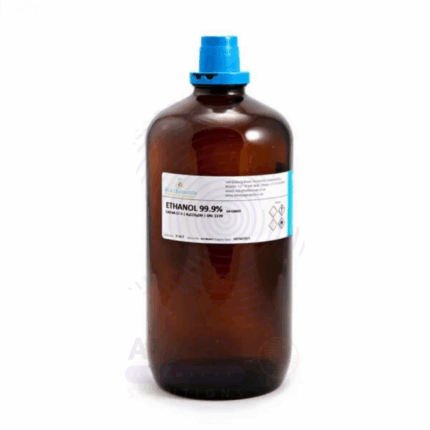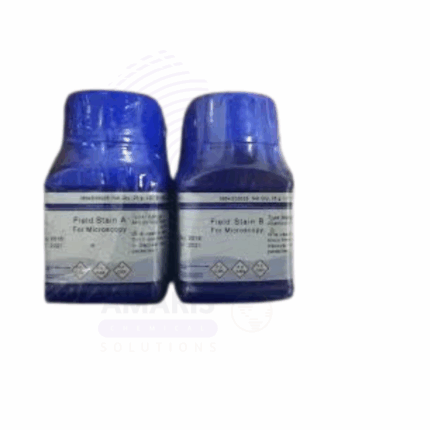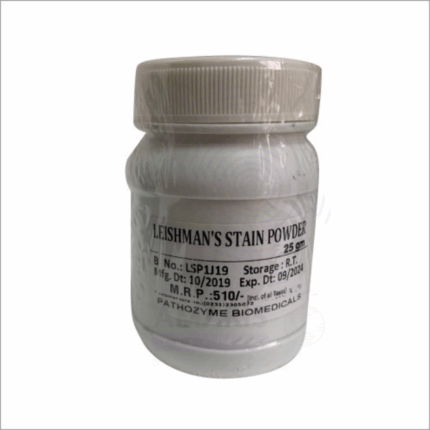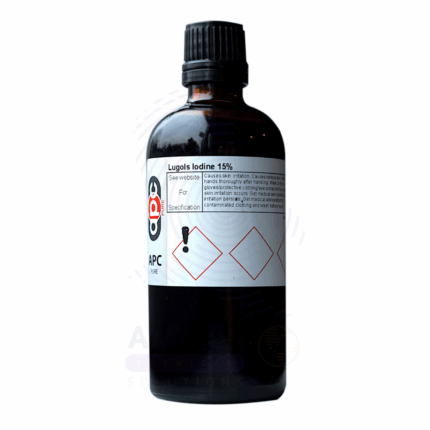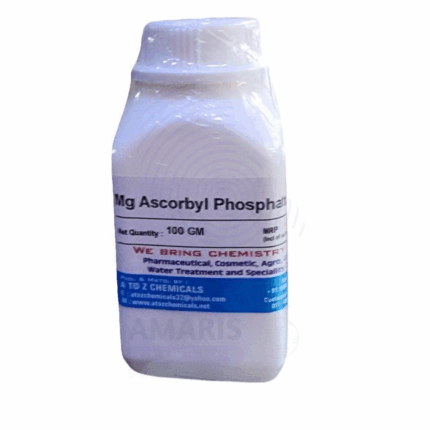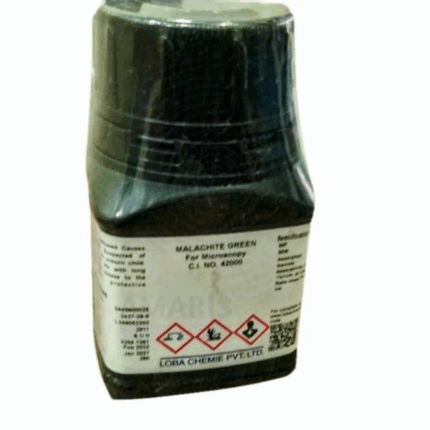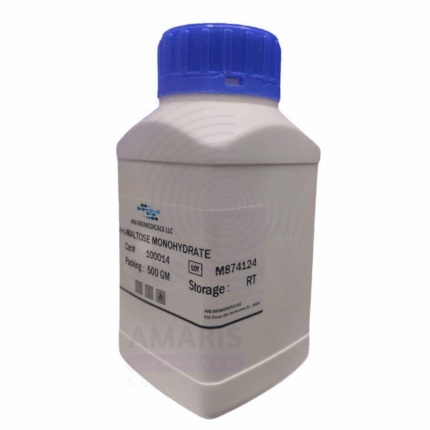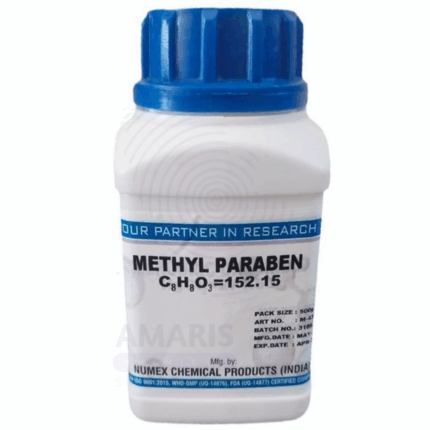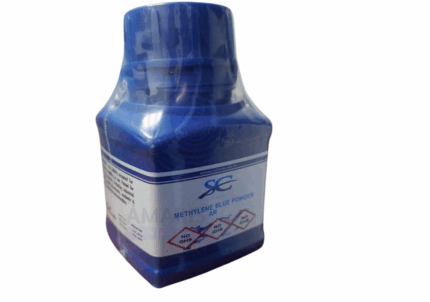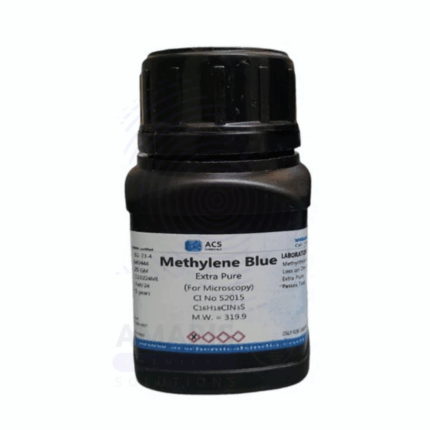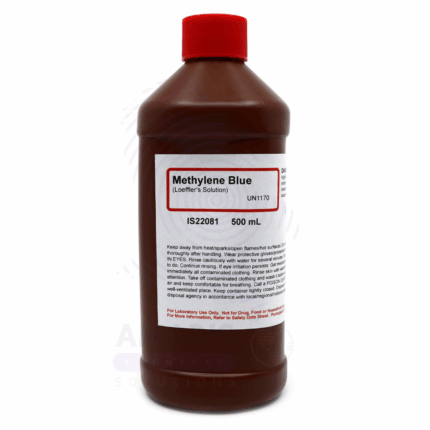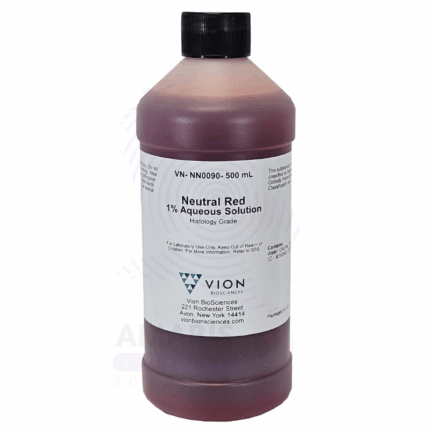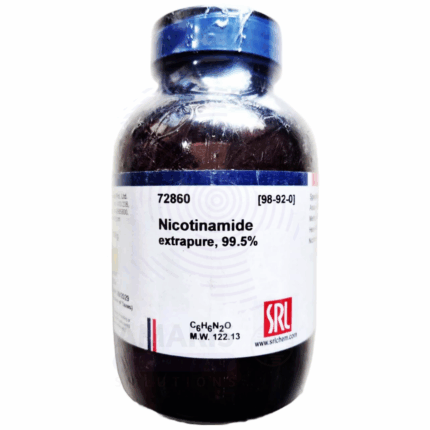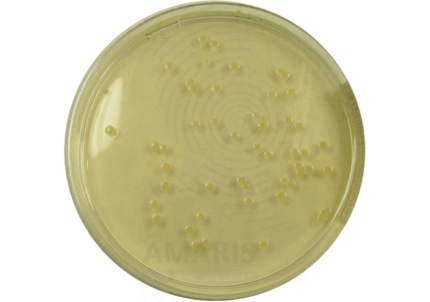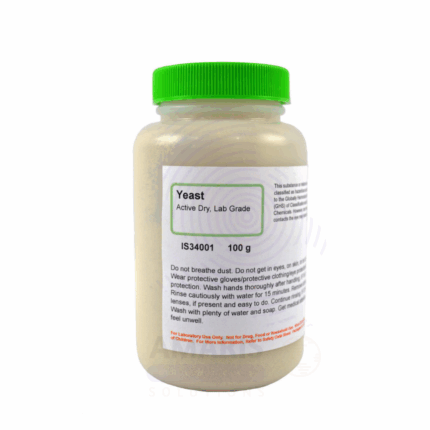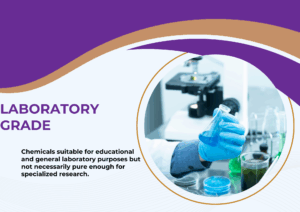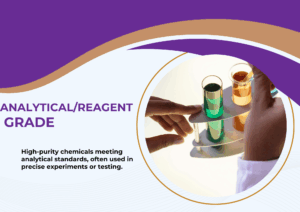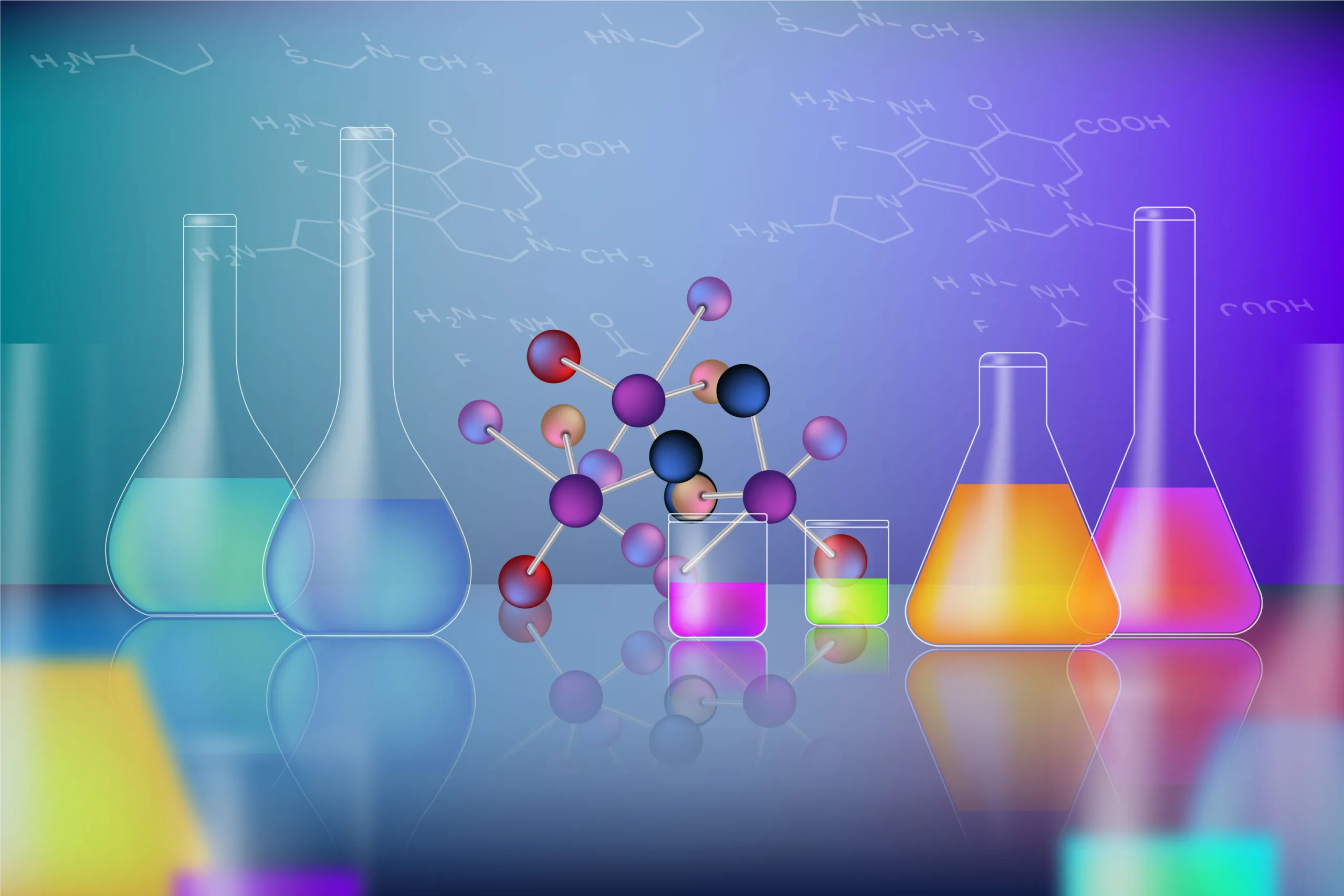
Microbiology and cell culture reagents are specialized chemicals and biological substances used to grow, maintain, and analyze microorganisms (bacteria, fungi, viruses) and eukaryotic cells in controlled laboratory conditions. These reagents ensure optimal growth conditions, sterility, and experimental accuracy in research, diagnostics, and biopharmaceutical production
Albumen From Egg Powder Extra Pure
Albumen from Egg Powder Extra Pure is a high-purity, finely milled powder derived from the whites of hen eggs, known for its exceptional binding, foaming, and emulsifying properties. This premium-grade product is widely used in biochemical research, microbiological media, and pharmaceutical formulations where high protein content and purity are essential. Its excellent solubility in water and consistent performance make it ideal for applications in diagnostics, nutritional studies, and electrophoresis. In addition, it serves as a reliable protein source in specialized dietary products and laboratory-grade food testing. To preserve its functionality and shelf life, Albumen Powder should be stored in a tightly sealed container, away from moisture and heat.
Basic Bismarck Mahogany Stain
Basic Bismarck Mahogany Stain is a high-quality wood stain formulated to impart a rich, warm mahogany hue to wooden surfaces. It enhances the natural grain of wood while providing long-lasting color and protection. Suitable for both interior and exterior applications, this stain penetrates deeply for durable, even coverage. It is widely used in woodworking, furniture finishing, and construction to achieve an attractive and classic mahogany finish.
Brilliant Green Extra Pure
Brilliant Green Extra Pure is a high-purity, intense green dye primarily used in microbiology and analytical laboratories for staining and selective microbial inhibition. It is especially effective in culture media to isolate specific bacterial strains, such as Salmonella spp., by suppressing the growth of gram-positive organisms. In addition to its antimicrobial role, it serves as a histological stain in biological research and is used in tracing, titration, and other colorimetric assays. The extra pure grade guarantees high dye content, minimal impurities, and excellent consistency, ensuring reliable results in sensitive and precise laboratory work. It should be stored in a tightly sealed container, away from direct light and heat, to preserve its stability and effectiveness.
Dextrose Monohydrate Extra Pure
Dextrose Monohydrate Extra Pure is a high-purity crystalline form of glucose containing one molecule of water. It is widely used in laboratory settings as a carbon source in microbial culture media, fermentation processes, and biochemical assays. Its precise composition and consistent solubility make it ideal for preparing nutrient solutions, buffers, and test reagents. In research and educational labs, it supports various metabolic and enzymatic studies. This extra pure grade ensures minimal impurities, providing reliable results in sensitive analytical and biological applications. Store in a tightly sealed container in a cool, dry place to preserve its quality and prevent clumping.
Dextrose Monohydrate Glucose Extra Pure
Dextrose Monohydrate Glucose Extra Pure is a laboratory-grade form of glucose with one molecule of water per glucose unit, offering high purity and excellent solubility in water. It serves as a vital energy source in microbiological culture media, fermentation experiments, and biochemical assays. Its predictable behavior and minimal impurities make it suitable for preparing reagents, buffers, and standard solutions in analytical and biological research. This compound is especially useful in cell culture work and metabolic studies where glucose is a key variable. Store in an airtight container away from moisture and direct sunlight to maintain its crystalline integrity.
Di-sodium Tetraborate Borax Extra Pure
Di-sodium Tetraborate Borax Extra Pure is a high-purity boron compound widely used in laboratory applications for its buffering, emulsifying, and fluxing properties. In analytical chemistry, it serves as a reagent in qualitative and quantitative analysis, particularly in flame tests and as a flux in the preparation of glass beads for spectroscopy. Its buffering capacity is valuable in maintaining pH stability in various solutions, while its detergent-like action supports cleaning and sample preparation. This extra pure grade ensures minimal contaminants, making it ideal for precision work in research, teaching, and industrial laboratories. Store in a cool, dry environment in a well-sealed container.
Diastase Enzyme Powder Extra Pure
Diastase Enzyme Powder Extra Pure is a high-activity amylolytic enzyme preparation used in laboratory settings to catalyze the breakdown of starch into simpler sugars like maltose and glucose. It plays a crucial role in biochemical and enzymatic assays, fermentation studies, and educational demonstrations involving carbohydrate metabolism. This extra pure grade ensures high enzyme purity, offering reliable and reproducible results in analytical work and research. Ideal for controlled hydrolysis experiments and studies on enzyme kinetics, it should be stored in a cool, dry place to preserve its enzymatic activity and stability.
Dipotassium Hydrogen Phosphate Extra Pure
Dipotassium Hydrogen Phosphate Extra Pure is a high-purity inorganic salt commonly used in laboratories as a buffering agent, particularly in the preparation of phosphate buffer solutions for biochemical and analytical procedures. It plays a vital role in maintaining stable pH conditions in enzymatic and molecular biology experiments. Additionally, it serves as a source of potassium and phosphorus in various chemical reactions and culture media. This extra pure grade ensures excellent consistency and low levels of contaminants, making it ideal for high-precision lab work. It should be stored in a cool, dry place, tightly sealed to avoid moisture absorption.
Disodium Hydrogen Phosphate Dihydrate Extra Pure
Disodium Hydrogen Phosphate Dihydrate Extra Pure is a laboratory-grade chemical widely utilized as a buffering agent and pH stabilizer in analytical chemistry, molecular biology, and biochemical research. It is commonly used in the preparation of phosphate buffer solutions, supporting the maintenance of optimal conditions for enzyme activity and cell culture. This dihydrate form ensures accurate hydration levels for reliable solution formulation. Its high purity makes it suitable for sensitive lab applications requiring minimal interference from impurities. The compound should be kept tightly sealed in a dry environment to preserve its integrity and reactivity.
Disodium Hydrogen Phosphate Extra Pure
Disodium Hydrogen Phosphate Extra Pure is a high-purity, anhydrous inorganic salt widely used in laboratory settings as a buffering agent, pH regulator, and reagent in chemical analysis. It plays a crucial role in preparing phosphate buffer systems for biochemical assays, molecular biology protocols, and microbial culture media. With its reliable solubility and consistent reactivity, it supports accurate calibration of pH in solutions. Its extra pure grade ensures minimal contamination, making it ideal for use in sensitive analytical and research environments. Proper storage in airtight containers is recommended to prevent moisture absorption and preserve its effectiveness.
Disodium Phosphate Extra Pure
Disodium Phosphate Extra Pure is a high-grade inorganic compound commonly used in laboratories as a buffering agent, emulsifier, and reagent. It is particularly valuable in preparing phosphate buffer solutions for biochemical and molecular biology applications. Its reliable pH-stabilizing properties make it ideal for use in analytical chemistry, food analysis, and preparation of reagent mixtures. With excellent solubility in water and minimal impurities, this extra pure form ensures accuracy and consistency in experimental results across a wide range of laboratory procedures.
Egg Albumen Extra Pure
Egg Albumen Extra Pure is a high-grade laboratory reagent derived from the white of eggs, known for its excellent protein content and binding properties. It is commonly used in biochemical experiments, protein electrophoresis, microbiological media, and as a blocking agent in immunoassays like ELISA. Its purity ensures consistent results in sensitive lab procedures involving protein interactions, enzyme activity studies, and cell culture applications.
Ethanol Extra pure
Ethanol Extra pure Extra Pure is a highly purified grade of ethyl alcohol widely used in laboratory, pharmaceutical, cosmetic, and analytical applications. At 99.8% purity, it contains minimal water, making it ideal for dehydration reactions, chromatography, spectroscopy, and cleanroom procedures. It serves as a universal solvent, disinfectant, and intermediate in chemical synthesis. This extra pure grade ensures low impurity levels, making it suitable for precision scientific experiments and pharmaceutical formulations. It is volatile and flammable, so it should be stored tightly sealed, in a cool, well-ventilated area, away from ignition sources.
Field Stain A and B Extra Pure
Field Stain A and B Extra Pure are specially formulated biological stains used primarily in hematology and microbiology for rapid differential staining of blood smears and parasites, especially in field conditions. Field Stain A typically contains methylene blue and azure dyes dissolved in a phosphate buffer, which preferentially stains the nuclei and cytoplasm of white blood cells. Field Stain B, on the other hand, contains eosin and counterstains the red blood cells and other acidic cellular components. Together, these stains provide excellent contrast and clarity, making them ideal for identifying malarial parasites and conducting quick diagnostic assessments in low-resource or remote environments. Their extra pure quality ensures minimal contamination, consistent performance, and reliable results in both clinical and educational settings.
Leishman Stainpowder Extra Pure
Leishman Stainpowder Extra Pure is a high-quality, finely milled formulation used extensively in hematology and parasitology for the microscopic staining of blood smears. Comprising mainly methylene blue and eosin, this stain is essential for differentiating white and red blood cells, as well as detecting malarial parasites and other blood-borne pathogens. Its excellent staining clarity and consistency make it a staple in clinical laboratories, diagnostic centers, and research institutions. The powder is reconstituted in methanol before use and must be handled with care, avoiding inhalation or contact with skin and eyes. Proper storage in a dry, cool environment ensures long-term stability and performance.
Lugols Iodine Extra Pure
Lugols Iodine Extra Pure is a superior-grade aqueous solution composed of elemental iodine and potassium iodide, known for its wide-ranging applications in laboratories, microscopy, and medical diagnostics. Valued for its strong staining properties, it is commonly used in biology to identify starch in plant cells and as a general-purpose cellular stain to enhance visibility under a microscope. Its extra pure formulation ensures high clarity, minimal impurities, and consistent results in sensitive applications. Additionally, it plays a role in preparing specimens, sterilization procedures, and certain medical antiseptic practices. Store tightly sealed, away from light and heat, to preserve potency.
Magnesium Ascorbyl Phosphate Extra Pure
Magnesium Ascorbyl Phosphate Extra Pure is a highly stable, water-soluble derivative of Vitamin C, widely appreciated for its exceptional antioxidant properties and gentle skin compatibility. Commonly used in cosmetic and dermatological formulations, it helps brighten the skin, reduce hyperpigmentation, and support collagen synthesis—making it a valuable ingredient in anti-aging and skin-repair treatments. Its stability against oxidation allows it to retain potency longer than pure ascorbic acid, especially in aqueous solutions. With pharmaceutical and cosmetic grade purity, this compound is ideal for use in serums, lotions, and creams targeting a healthy, radiant complexion.
Malachite Green Extra Pure
Malachite Green Extra Pure is a synthetic dye of exceptional purity, recognized for its intense green coloration and versatile laboratory uses. It is commonly used as a biological stain, especially in microbiology for identifying and differentiating bacterial species, and in histology for staining cell structures. Additionally, Malachite Green serves as an effective fungicide and antiparasitic agent in aquaculture and laboratory testing. Its high purity ensures reliable performance in analytical applications, including redox titrations and as a pH indicator in specific chemical reactions. Its vivid color and chemical stability make it a valuable reagent in both teaching and professional research settings.
Maltose Extra Pure
Maltose Extra Pure is a disaccharide composed of two glucose units, commonly known as malt sugar. This extra pure grade ensures exceptional quality and consistency, making it ideal for use in biochemical research, fermentation studies, and laboratory analysis. In the food industry, maltose is valued for its mild sweetness and is often used in brewing, baking, and confectionery to promote fermentation and enhance flavor. It also plays a role in energy metabolism studies and is frequently used as a carbon source in microbiological media. Its stability and solubility in water make it easy to incorporate into various formulations, offering a dependable ingredient for scientific and industrial use where high purity is essential.
Methyl Paraben Extra Pure
Methyl Paraben Extra Pure is a high-purity chemical widely used as a preservative in pharmaceuticals, cosmetics, personal care products, and food applications. It is valued for its strong antimicrobial and antifungal properties, helping to extend the shelf life of various formulations by preventing the growth of bacteria and mold. In laboratories, it is commonly employed in microbiological media and analytical standards. Its excellent stability across a broad pH range, combined with low toxicity and high efficacy even at low concentrations, makes it a preferred choice in sensitive applications. This extra pure grade ensures consistent quality and performance for critical uses.
Methylene Blue Powder Extra Pure
Methylene Blue Powder Extra Pure is a high-grade dye with diverse laboratory and industrial applications. It is widely used as a biological stain in microscopy for highlighting cellular structures such as nuclei, bacteria, and parasites, particularly in blood smear and bacteriological studies. In chemistry, it serves as a redox indicator due to its distinct color change properties, and in aquaculture, it acts as a treatment for fungal and bacterial infections in fish. Its extra pure formulation ensures maximum staining clarity, minimal contamination, and reliable results in research, diagnostics, and educational settings.
Methylene Blue Solution Extra Pure
Methylene Blue Solution Extra Pure is a ready-to-use aqueous formulation of high-purity methylene blue dye, ideal for laboratory, biological, and analytical applications. It is commonly employed as a vital stain in microscopy to highlight cellular components such as nuclei and mitochondria, especially in live or fixed cells. This solution also functions as a redox indicator in various chemical experiments and is used in microbiology for bacterial identification and differentiation. With its extra pure quality, the solution delivers consistent and precise staining results, making it a reliable tool for research, diagnostics, and teaching laboratories.
Neutral Red Solution Extra Pure
Neutral Red Solution Extra Pure is a high-purity, ready-to-use solution of the pH indicator dye Neutral Red, widely employed in biological, biochemical, and analytical laboratories. Known for its distinct color change—red in acidic environments and yellow in alkaline—it is commonly used to stain lysosomes in viable cells, making it invaluable in cell viability assays, cytotoxicity studies, and microscopic cell structure investigations.
This Extra Pure grade ensures excellent clarity and precision in results, especially in sensitive microbiological and histological procedures. It is frequently used in conjunction with culture media to observe metabolic activities and in vital staining techniques to differentiate between live and dead cells. Proper handling involves storing it in tightly sealed amber containers away from light and heat to maintain its stability and effectiveness.
Nicotinamide Extra Pure
Nicotinamide Extra Pure is a refined, high-purity form of vitamin B3, widely recognized for its essential role in human and animal health. It serves as a vital component in the synthesis of NAD⁺ and NADP⁺, coenzymes that are fundamental to numerous metabolic and enzymatic reactions in living cells. In laboratory settings, it is frequently used in biochemical research, cell culture media, and vitamin assays due to its stable and bioactive nature.
In pharmaceutical applications, nicotinamide is commonly used in the formulation of supplements and dermatological treatments, where it supports skin barrier function, reduces inflammation, and helps alleviate acne and hyperpigmentation. Its presence in cosmetic products is valued for promoting smoother, more even-toned skin. The Extra Pure grade guarantees minimal impurities, making it ideal for sensitive applications in health care, research, and personal care products. It should be stored in a cool, dry environment away from light to maintain its integrity.
Nutrient Agar
Nutrient Agar is a general-purpose solid growth medium used extensively in microbiology laboratories for the cultivation of a wide variety of non-fastidious microorganisms. It consists of a blend of peptones, beef extract, and agar as the solidifying agent. Nutrient Agar supports the growth of bacteria and fungi, providing essential nutrients such as amino acids, nitrogen, vitamins, and minerals.
Yeast Active Dry Extra Pure
Yeast Active Dry Extra Pure is a high-quality, dry granulated form of Saccharomyces cerevisiae, widely used as a biological reagent in microbiological, biochemical, and fermentation research. Its consistent purity and viability make it ideal for laboratory studies involving fermentation, enzymatic activity, genetic research, and bioprocessing. It is also a key component in pharmaceutical and biotechnological applications, supporting recombinant protein production and probiotic development. The dry, stable form allows for easy storage and precise dosing. Proper handling is important to avoid moisture contamination and dust inhalation.

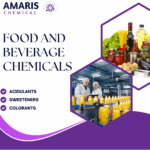
 Preservatives(food)
Preservatives(food) Flavor Enhancers
Flavor Enhancers Acidulants
Acidulants Sweeteners
Sweeteners Antioxidants
Antioxidants Colorants(food)
Colorants(food)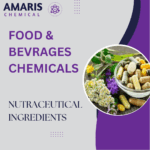 Nutraceutical Ingredients (food)
Nutraceutical Ingredients (food) Nutrient Supplements
Nutrient Supplements Emulsifiers
Emulsifiers
 Collectors
Collectors Dust Suppressants
Dust Suppressants Explosives and Blasting Agents
Explosives and Blasting Agents Flocculants and Coagulants
Flocculants and Coagulants Frothers
Frothers Leaching Agents
Leaching Agents pH Modifiers
pH Modifiers Precious Metal Extraction Agents
Precious Metal Extraction Agents
 Antioxidants(plastic)
Antioxidants(plastic) Colorants (Pigments, Dyes)
Colorants (Pigments, Dyes) Fillers and Reinforcements
Fillers and Reinforcements Flame Retardants
Flame Retardants Monomers
Monomers Plasticizers
Plasticizers Polymerization Initiators
Polymerization Initiators Stabilizers (UV, Heat)
Stabilizers (UV, Heat)
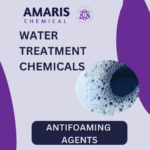 Antifoaming Agents
Antifoaming Agents Chelating Agents
Chelating Agents Coagulants and Flocculants
Coagulants and Flocculants Corrosion Inhibitors
Corrosion Inhibitors Disinfectants and Biocides
Disinfectants and Biocides Oxidizing Agents
Oxidizing Agents pH Adjusters
pH Adjusters Scale Inhibitors( water)
Scale Inhibitors( water)
 Antioxidants(cosmetic)
Antioxidants(cosmetic) Emollients
Emollients Fragrances and Essential Oils
Fragrances and Essential Oils Humectants
Humectants Preservatives
Preservatives Surfactants(cosmetic)
Surfactants(cosmetic) Thickeners
Thickeners UV Filters
UV Filters
 Fertilizers
Fertilizers Soil Conditioners
Soil Conditioners Plant Growth Regulators
Plant Growth Regulators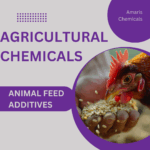 Animal Feed Additives
Animal Feed Additives Biostimulants
Biostimulants Pesticides (Herbicides, Insecticides, Fungicides)
Pesticides (Herbicides, Insecticides, Fungicides)
 Active Pharmaceutical Ingredients (APIs)
Active Pharmaceutical Ingredients (APIs) Excipients
Excipients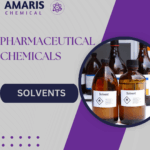 Solvents(pharmaceutical)
Solvents(pharmaceutical) Antibiotics
Antibiotics Antiseptics and Disinfectants
Antiseptics and Disinfectants Vaccine Adjuvants
Vaccine Adjuvants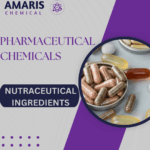 Nutraceutical Ingredients (pharmaceutical)
Nutraceutical Ingredients (pharmaceutical)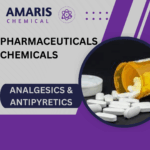 Analgesics & Antipyretics
Analgesics & Antipyretics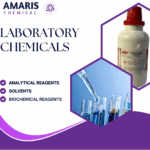
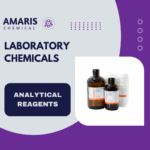 Analytical Reagents
Analytical Reagents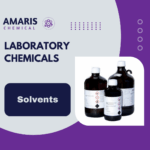 Solvents(lab)
Solvents(lab)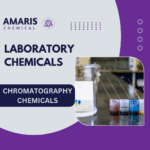 Chromatography Chemicals
Chromatography Chemicals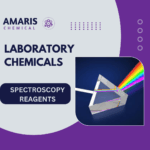 Spectroscopy Reagents
Spectroscopy Reagents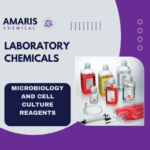 microbiology-and-cell-culture-reagents
microbiology-and-cell-culture-reagents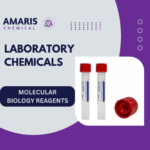 Molecular Biology Reagents
Molecular Biology Reagents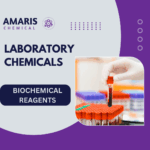 Biochemical Reagents
Biochemical Reagents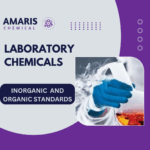 Inorganic and Organic Standards
Inorganic and Organic Standards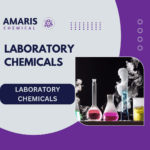 Laboratory Safety Chemicals
Laboratory Safety Chemicals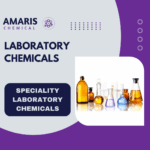 Specialty Laboratory Chemicals(Special Laboratory Equipment)
Specialty Laboratory Chemicals(Special Laboratory Equipment)
 Demulsifiers
Demulsifiers Hydraulic Fracturing Fluids
Hydraulic Fracturing Fluids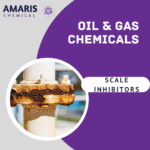 Scale Inhibitors(oil)
Scale Inhibitors(oil) Surfactants(oil)
Surfactants(oil) Drilling Fluids
Drilling Fluids
 Dyes and Pigments
Dyes and Pigments Bleaching Agents
Bleaching Agents Softening Agents
Softening Agents Finishing Agents
Finishing Agents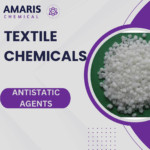 Antistatic Agents
Antistatic Agents
 Admixtures
Admixtures Waterproofing Agents
Waterproofing Agents Sealants and Adhesives
Sealants and Adhesives Curing Compounds
Curing Compounds Concrete Repair Chemicals
Concrete Repair Chemicals Anti-Corrosion Coatings
Anti-Corrosion Coatings
 Surfactants(cleaning)
Surfactants(cleaning) Builders
Builders Enzymes
Enzymes Solvents (Cleaning)
Solvents (Cleaning) Fragrances
Fragrances
 Electronic Chemicals
Electronic Chemicals Catalysts
Catalysts Lubricants
Lubricants Photographic Chemicals
Photographic Chemicals Refrigerants
Refrigerants Automotive chemicals
Automotive chemicals Pyrotechnic Chemicals
Pyrotechnic Chemicals
 Biodegradable Surfactants
Biodegradable Surfactants Bio-based Solvents
Bio-based Solvents Renewable Polymers
Renewable Polymers Carbon Capture Chemicals
Carbon Capture Chemicals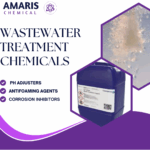 Wastewater Treatment Chemicals
Wastewater Treatment Chemicals
 Pigments
Pigments Solvents(paint)
Solvents(paint) Specialty Coatings
Specialty Coatings Binders/Resins
Binders/Resins Additives
Additives Driers
Driers Anti-Corrosion Agents
Anti-Corrosion Agents Functional Coatings
Functional Coatings Application-Specific Coatings
Application-Specific Coatings
 Fresh Herbs
Fresh Herbs Ground Spices
Ground Spices Whole Spices
Whole Spices Spice Blends
Spice Blends Dried Herbs
Dried Herbs
 Leavening Agents
Leavening Agents Dough Conditioners
Dough Conditioners Flour Treatments
Flour Treatments Fat Replacers
Fat Replacers Decoratives
Decoratives Preservatives(baking)
Preservatives(baking)
 Plasticizers & Softeners
Plasticizers & Softeners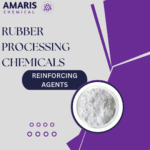 Reinforcing Agents
Reinforcing Agents Adhesion Promoters
Adhesion Promoters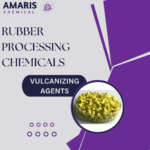 Vulcanizing Agents
Vulcanizing Agents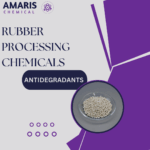 Antidegradants
Antidegradants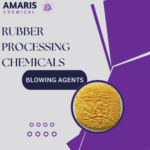 Blowing Agents
Blowing Agents Fillers & Extenders
Fillers & Extenders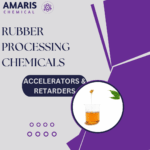 Accelerators & Retarders
Accelerators & Retarders














